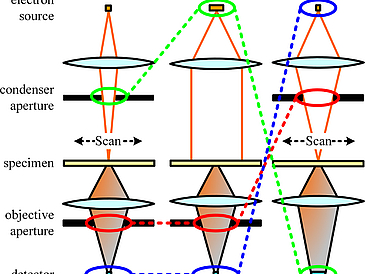Florian F. Krause, Marco Schowalter, Beeke Gerken, Dennis Marquardt, Tim Grieb, Thorsten Mehrtens, Christoph Mahr, Andreas Rosenauer
Ultramicroscopy, 245, 113661, 2023
https://doi.org/10.1016/j.ultramic.2022.113661
The ISTEM mode for TEM has been demonstrated to have several advantages in regard to resolution and precision. While previous works primarily focussed on the advantages due to the reduced spatial coherence, the actual image contrast, i.e. how bright or dark certain atom columns are imaged, has mostly been of secondary concern. The present work sets out to achieve the contrast of annular bright field STEM in ISTEM, producing the high contrast of light elements, for which this method is popular. It is shown from theoretical considerations that using an annular condenser aperture this aim can be realised. The optimal size of this aperture is found by simulative studies. It is then manufactured from platinum foil and installed in an image-aberration corrected microscope. ABF-like ISTEM images of strontium titanate [100] in projection are acquired. The pure oxygen columns are clearly resolved with significant contrast. The image pattern is indeed identical to what is achieved by ABF STEM. A close look at the image formation also shows that the dose needed for a given signal-to-noise ratio is at least a quarter smaller for ABF-like ISTEM compared to ABF STEM, assuming detectors of similar detective quantum efficiency.


